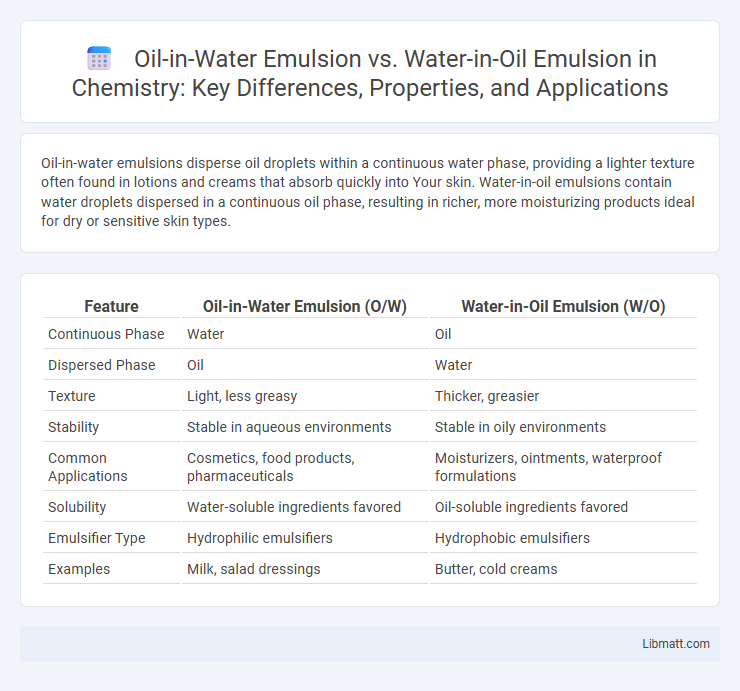Oil-in-water emulsions disperse oil droplets within a continuous water phase, providing a lighter texture often found in lotions and creams that absorb quickly into Your skin. Water-in-oil emulsions contain water droplets dispersed in a continuous oil phase, resulting in richer, more moisturizing products ideal for dry or sensitive skin types.
Table of Comparison
| Feature | Oil-in-Water Emulsion (O/W) | Water-in-Oil Emulsion (W/O) |
|---|---|---|
| Continuous Phase | Water | Oil |
| Dispersed Phase | Oil | Water |
| Texture | Light, less greasy | Thicker, greasier |
| Stability | Stable in aqueous environments | Stable in oily environments |
| Common Applications | Cosmetics, food products, pharmaceuticals | Moisturizers, ointments, waterproof formulations |
| Solubility | Water-soluble ingredients favored | Oil-soluble ingredients favored |
| Emulsifier Type | Hydrophilic emulsifiers | Hydrophobic emulsifiers |
| Examples | Milk, salad dressings | Butter, cold creams |
Introduction to Emulsions
Oil-in-water (O/W) emulsions consist of oil droplets dispersed in a continuous water phase, commonly found in food products, cosmetics, and pharmaceuticals. Water-in-oil (W/O) emulsions contain water droplets dispersed in a continuous oil phase, often used in moisturizing creams and ointments due to their hydrophobic properties. The stability and functionality of these emulsions depend on factors such as emulsifier type, droplet size, and phase volume ratio.
Understanding Oil-in-Water Emulsions
Oil-in-water emulsions consist of oil droplets dispersed in a continuous water phase, commonly used in pharmaceuticals, cosmetics, and food products for their lighter texture and easy washability. Understanding oil-in-water emulsions involves recognizing their high water content, which enhances hydration and reduces greasiness, making them ideal for your skincare routine when a non-greasy moisturizer is preferred. Their stability depends on emulsifiers that lower surface tension, preventing droplet coalescence and ensuring a uniform, smooth formulation.
Exploring Water-in-Oil Emulsions
Water-in-oil emulsions consist of water droplets dispersed within an oil continuous phase, providing superior water resistance and enhanced moisturizing properties, making them ideal for skincare and cosmetic formulations. These emulsions offer excellent stability in water-resistant sunscreens and barrier creams due to their robust oil matrix, which effectively traps and isolates the aqueous phase. The unique structure of water-in-oil emulsions supports slow release of active ingredients and improved skin barrier reinforcement compared to oil-in-water emulsions.
Key Differences: O/W vs W/O Emulsions
Oil-in-water (O/W) emulsions consist of oil droplets dispersed in a continuous water phase, making them more hydrophilic and easier to wash off, commonly used in cosmetics and pharmaceuticals. Water-in-oil (W/O) emulsions have water droplets dispersed in a continuous oil phase, providing superior moisturizing properties and enhanced barrier protection, ideal for skin creams and ointments. The primary distinctions lie in their phase dispersion, hydrophilicity, and application suitability based on solubility and texture preferences.
Common Applications of Oil-in-Water Emulsions
Oil-in-water emulsions are widely used in cosmetic formulations such as moisturizers and sunscreens due to their light texture and ease of absorption by the skin. In the food industry, they serve as bases for products like milk, salad dressings, and sauces, providing a stable and palatable mixture. Your choice of emulsion type can influence product formulation, stability, and user experience in various industries.
Typical Uses of Water-in-Oil Emulsions
Water-in-oil emulsions are commonly used in cosmetic products like moisturizing creams and sunscreens due to their superior moisturizing properties and ability to create a protective barrier on the skin. These emulsions are also prevalent in industrial applications such as metalworking fluids and certain pharmaceuticals, where controlled water release and oil continuity are critical. Understanding the typical uses of water-in-oil emulsions can help you choose the best formulation for hydration or protective needs.
Emulsifying Agents and Their Role
Emulsifying agents stabilize oil-in-water (O/W) and water-in-oil (W/O) emulsions by reducing interfacial tension between the two immiscible liquids, ensuring consistent mixing. In O/W emulsions, hydrophilic emulsifiers like polysorbates support the dispersion of oil droplets in a continuous aqueous phase, while W/O emulsions rely on lipophilic emulsifiers such as sorbitan esters to encapsulate water droplets within an oil phase. Your choice of emulsifying agents directly influences the emulsion's stability, texture, and intended application in industries like cosmetics, pharmaceuticals, or food.
Stability Factors in Emulsion Types
Oil-in-water (O/W) and water-in-oil (W/O) emulsions exhibit distinct stability factors primarily influenced by the dispersed phase volume, emulsifier type, and droplet size. O/W emulsions are generally stabilized by hydrophilic emulsifiers that reduce interfacial tension and promote small droplet size, enhancing kinetic stability against coalescence. W/O emulsions require lipophilic emulsifiers to maintain integrity, with stability heavily dependent on the continuous oil phase's viscosity and the proper balance of internal aqueous phase to prevent phase inversion.
Advantages and Disadvantages Comparison
Oil-in-water emulsions offer superior skin hydration and are typically lighter, making them ideal for daily moisturizing without leaving a greasy residue; however, they may be less effective for dry skin types due to lower oil content. Water-in-oil emulsions provide better occlusion and longer-lasting protection for dry or sensitive skin, but their heavier texture can feel sticky and may clog pores. Your choice depends on skin type and desired product performance, balancing hydration versus barrier protection.
Selecting the Right Emulsion for Your Needs
Selecting the right emulsion depends on the desired application and stability requirements; oil-in-water (O/W) emulsions are typically preferred for cosmetic and pharmaceutical products due to their ease of washability and lighter texture. Water-in-oil (W/O) emulsions offer superior moisture retention and are ideal for barrier creams and heavy-duty skin protection. Understanding factors such as hydrophilic-lipophilic balance (HLB), droplet size, and intended skin feel ensures optimal formulation performance and user experience.
Oil-in-water emulsion vs water-in-oil emulsion Infographic

 libmatt.com
libmatt.com